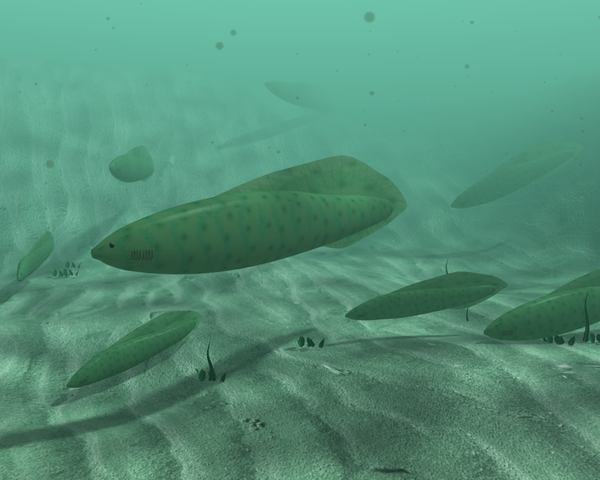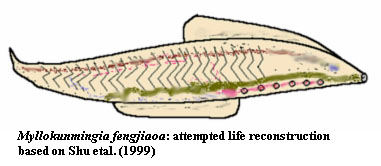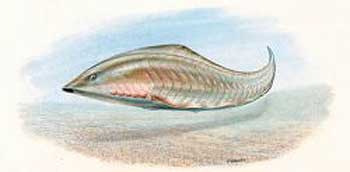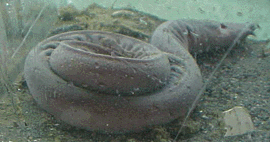
Life reconstruction of the basal craniate or vertebrate Haikouichthys ercaicunensis. Length: 2.5 cm. All vertebrate animnals descended from a humble ancestor such as this.
| Vertebrata | ||
| The Vertebrates | Craniata |
| Vertebrates Home | Vertebrate | Vertebrate |
|
Abbreviated Dendrogram
Chordata
│
└─○Craniata
├─Myllokunmingia
├─Haikouichthys
└─┬─Zhongjianichthys
├─Myxinoidea
└─Vertebrata
├─Jamoytiiformes
└─┬─Hyperoartia (= Petromyzontiformes)
└─┬─Conodonta
└─┬─Anaspida
└─┬─Pteraspidomorphi
╘═╤═Thelodonti
╘═╤═Cephalaspidomorphi
└─Gnathostomata
|
Contents
Overview |
 |
Life reconstruction of the basal craniate or vertebrate Haikouichthys ercaicunensis. Length: 2.5 cm. All vertebrate animnals descended from a humble ancestor such as this. |
Here we enter a strange and poorly known area of phylospace, one in which both timing and phylogeny are poorly understood. Somewhere between 750 and 550 million years ago, a new line of chordates evolved. These were characterised by a relatively concentrated set of sensory neurons at the anterior end and a particularly pronounced notochord extending beyond the anterior and posterior ends of the torso. In other words, they had the beginnings of a head and a tail. In addition, probably as a later development, the myomeres, the charcateristic bands of muscle along the torso, were reorganized in dorsal and ventral halves, separated by a septum, and acquired a distinctive 'V'- or 'W'-shape. These folks were our ancestors among chordate-kind.

The last common ancestor of hagfish and you, with all of its descendants, is referred to as Craniata. Craniates are animals with well-developed heads and a skull of sorts. A very early craniate, Myllokunmingia from the Cambrian of China, is badly illustrated in the figure at right. A rather better illustration of a possibly related and similar form is shown here. Since there is no really good reason to suppose that Haikouella belonged to this clade, we treat as a sort of "craniatomorph," but not a craniate.
From the first craniates evolved a bewildering variety of creatures. At least they have bewildered systematists for over a century. The first step seems relatively clear. The most primitive craniates we know are the living Myxinoidea (hagfishes): eel-like, rather assymmetric creatures with a strong propensity to flood their immediate neighborhood with slime at the slightest provocation. All other known craniates are Vertebrates. ATW020417.
 |
The ancestral craniate Myllokunmingia fengjiaoa, as it may have appeared in life. Note that this illustration is highly speculative; it is not known for example if Myllokunmingia had eyes, although it is usually drawn that way, perhaps for anthropomorphic or anthropocentric reasons. See also reconstruction of the very similar Haikouichthys . |
Craniata: Myllokunmingia, ?Haikouichthys
From the Tommotian
Chordata::: Haikouella + *: Myxinoidea + Vertebrata.
Neural crest cells, somites, gills with cartilagenous or bone supports (absent in Myllokunmingia?), tripartite brain and paired cranial sense organs, cranium with anterior notochord, semi-circular canal(s), 1 heart, kidneys.
Comments: The description by Shu et al. (1999) of Myllokunmingia from the Lower Cambrian of South China is generally what one might have expected of a very primitive craniate. The surprising exception is the probable presence of paired fin folds, as well as a definite dorsal fin. None of the fins have detectable radials. The state of preservation is also insufficient to state whether Myllokunmingia had eyes, a single heart, an anterior notochord, or even a brain, so that the exact position of this fossil is uncertain. Shu describes it as a vertebrate, but the evidence is unclear. Perhaps it is better treated as a pre-vertebrate craniate since, as Shu states, it is not part of the crown group vertebrates, defined as the LCA of lampreys and gnathostomes.
Links: Waking Up to the Dawn of Vertebrates, Science News Online (11/6/99); BBC News | Sci/Tech | Oldest fossil fish caught. ; Craniata; UW-Green Bay Cofrin Arboretum Center for Biodiversity - - ...; Craniata.
References: Janvier 1999); Shu et al. (1999); Zimmer 2000). APW040314.
Myllokunmingia fengjiaoa Shu, Zhang & Han
Early Cambrian Maotianshan shales of China (Yunnan Province, Chengjiang County).
Basal Craniate/ basal Vertebrate
Size: around 28 mm long and 6 mm high
Comments: appears to have a skull and skeletal structures made of cartilage. There is no sign of mineralization of the skeletal elements (biomineralization). The holotype was found in the Yuanshan member of the Qiongzhusi Formation in the Eoredlichia Zone near Haikou at Ercaicun, Kunming City, Yunnan, China. The animal has a distinct head and trunk with a forward sail-like (1.5 mm) dorsal fin and a ventral fin fold (probably paired) further back. The head has five or six gill pouches with hemibranchs. There are 25 segments (myomeres) with rearward chevrons in the trunk. There is a notochord, a pharynx and digestive tract that may run all the way to the rear tip of the animal. The mouth cannot be clearly identified. There may be a pericardic cavity. There are no fin radials. There is only one specimen which has the tip of the tail buried in sediment. A similar creature from these shales is known as Haikouichthys. Other suspected chordates (primitive hemichordates) are also known from these deposits. BILL 061113, HAJ090202.
Haikouichthys ercaicunensis Luo et al., 1999
Early Cambrian Maotianshan shales of China.
Basal Craniate/ basal vertebrate
gills supported by gill bars, a more advanced ararngement than the contemporary Myllokunmingia fengjiaoa (BBC Sci/Tech); small lobate extension to the head, with eyes and possible nasal sacs and otic capsules. Notochord with separate vertebral elements. (Shu et al 2003)
Size: about 2.5 cm long
Comments: a fish from Haikou, China, not verse from Japan. APW040314. Cladistic analysis indicates that the animal is probably a primitive agnathan fish most closely related to the lampreys. It is narrower than Myllokunmingia, another primitive fish that comes from the same beds. The holotype was found in the Yuansshan member of the Qiongzhusi Formation in the Eoredlichia Zone near Haikou at Ercaicun, Kunming City, Yunnan, China. The animal has a distinct head and trunk. The head has at least six and perhaps nine probable gills. There are a number of segments (myomeres) with rear directed Vs in the trunk. There is probably a notochord although only a short segment is preserved in the single known specimen. The tail end of the animal is apparently missing. There is a prominent dorsal fin with fin radials. The fin radials seem to angle "forward" toward the end thought on the basis of internal structures to be the head. This happens with a few modern fish but is an uncommon arrangement. There is a ventral fin fold. There are 13 circular structures along the bottom that may be gonads, slime organs, or something else entirely. There is no sign of mineralization of the skeletal elements. BILL 061113 Previously considered a possible basal lamprey, new analysis by Sansom et al now places it as a basal craniate MAK111022. The holotype was found in the Yuansshan member of the Qiongzhusi Formation in the 'Eoredlichia' Zone near Haikou at Ercaicun, Kunming City, Yunnan, China (Wikipedia). Phylogenetic analysis indicate that this species lies within the stem-group craniates. Although Haikouichthys resembles the ammocoete larva of modern lampreys, this is likely a symplesiomorphy (shared primitive feature). (Shu et al 2003). Cladistic analysis places Haikouichthys either as more derived (advanced) than hagfish Shu et al 2003) or in an unresolved polytomy or more basal than them (Sansom et al 2010). We have followed Shu 2003 and Janvier, 2003 in considering these stem vertebrates more basal. MAK111027
Links: BBC News Sci/Tech Walking with Wiki
Early Cambrian Maotianshan shales of China.
Basal vertebrate
Eyes are located behind the antero-dorsal lobe (an advanced feature, in Jamoytius the eyes are forward-positioned); absence of myotome impressions, indicating thicker epidermis, consisting of multiple layers of cells, as in living lower craniates (lamprey and hagfish). (Shu 2003)
Comments: Another of the tiny enigamtic proto-vertebrates whose fossil remains have been discovered in China. Similar to but more advanced than the contemporary Haikouichthys and Myokunmingia. It may be a vertebrate proper, or simply independently aqcuired these features, just as a number of lineages of amphibians during the Carboniderous were independently evolving to the reptilian condition. An eel-like, elongated form; Its reduced fins suggest that it did not swim frequently, if at all.
Reference: Shu 2003
Links: Deviant Art
 Myxinoidea: Hagfish (Myxine, Neomyxine, Paramyxine, Eptatretus).
Myxinoidea: Hagfish (Myxine, Neomyxine, Paramyxine, Eptatretus).
from the Late Carboniferous
Craniata: Vertebrata + *.
Anterior nasal opening; "taste" per unique neural and sensory system; mouth surrounded by ring of tentacles; rasping tongue with keratinous teeth; velum; water inhaled through separate nasopharyngeal opening; cartilagenous braincase and branchial basket; poorly developed eyes, with no lenses; gills asymmetric; no vertebrae, finrays absent; no muscles in caudal web fin; scales absent; numerous dermal mucous glands; no lateral line neuromasts; primitive kidney; aneural heart & accessory hearts; isomolal body fluid; benthic and nektobenthonic; marine (deep shelf); ties itself into slip knot to remove food; scavengers; very low metabolism.
Links: link: UC Berkeley; OceanLink: OceanInfo - The Hagfish Page; Hyperotreti; Agnatha.Head.pdf; Hagfish At Home; Pirålar. APW040314.
checked ATW031116, revised MAK111027